
The today’s flag of Somaliland was introduced on 14th of October in 1996. It shows three horizontal stripes in green, white and red, furthermore in the green stripe in white the "Shahada" and in the white stripe a black five-pointed star. Article 7 of the Constitution of the Republic of Somaliland of 2001 regulates the appearance of the flag, mentioning among other things the colours green and red, which, however, are not specified further. The Shahada is the confessional credo of the Islam ("Allah il Allah, wa Muhammad rasul Allah" → "There is no God but God; and Mohammed is His messenger"). The black star is the "lead-star of the african freedom", like he is often to see on African flags. About the meaning of the colours is nothing known. The colours red, green and white are obviously from pivotal significance for the Somali people, because the colours arise on Somali flags again and again (Ogaden, WSLF, SPM Jubaland, Southwest Somalia). Green stands because of the combination with the Shahada probably also for the Islam. As Somaliland separated itself from Somalia on 18th of May in 1991 was adoped a white flag which showed in the middle a green disk surrounded by Arabian letters. This flag was in use until the introduction of the today’s flag on 14th of October in 1996. As Somaliland became independent from United Kingdom on 26th of June in 1960 it was taken over the flag of Italian Somaliland. This flag showed a single-coloured pale blue bunting with a white five-pointed star in the middle. British Somaliland came into being in 1887 after the British had taken power in Egyptian Somaliland in February 1884. Egypt had been conquered by United Kingdom in 1882, but was initially under the administration of British India from Aden. In 1903, British Somaliland received its own administration and thus its own governor. This gave the British administration of the colony the right to use its own so-called "Blue Ensign", a dark blue flag bunting with a representation of a flag - the British Union Jack - in the upper corner, with a badge in the waving end. For all other purposes, only the British Union Jack was to be used on land and the usual red British merchant flag, the "Red Ensign", was to be used at sea.
United Kingdom introduced a flag system in 1864 in which:
• war ships fly the "White Ensign" (naval flag), a white flag often with an uninterrupted red St. George's-Cross and with the Union Jack in the upper staff quadrant of the flag,
• merchant ships fly a "Red Ensign" (also named "Civil Ensign" → civil flag, the real merchant flag), a red flag with the Union Jack in the upper staff quadrant of the flag, and
• governmental ships fly the "Blue Ensign" (flag for the use by the gouvernment → the actual state flag), a blue flag with the Union Jack in the upper staff quadrant of the flag.
Since 1865 ships of colonial governments were permitted to fly the Blue Ensign with a badge in the flying end of the flag. The governments were asked to design appropriate badges. The in 1903 introduced emblem (badge) showed a Kudu antelope within a white disk. In 1950 was introduced a new badge.
Source:
Die Welt der Flaggen,
Flaggen und Coat of arms of the Welt,
Wikipedia (EN),
Flags of the World,
Volker Preuß

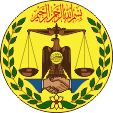
since 1996,
Coat of arms of Somaliland,
Source: Wikipedia (EN),
Abdullahi Abdi Omar (Jawaan),
Public domain, via Wikimedia Commons
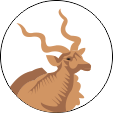
1903–1950,
Badge of British Somaliland,
Source, by: Flags of the World
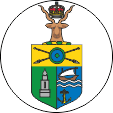
1950–1960,
Badge of British Somaliland,
Source, by: Flags of the World

The coat of arms of Somaliland is a golden coloured round seal. In it a stylized wreath from green twigs, two hands in handshaking, a libra and an eagle and an Islamic motto above it in red. The coat of arms is an allegory of the motto of the state. That is: "justice, peace, freedom, democracy and success for all". British Somaliland had its own administration from 1903, so its own badge was used here from 1903. It was a white disc with a Kudu Antelope on it. In 1950, a regular coat of arms had been introduced, which now appeared in the badge instead of the antelope. The badge showed on a white disk a shield and in its head were to see two crossed Somali spears and a Somali shield. The vertically divided shield showed on the one side an arabian dhau (sailing ship with one sail) stylized waves and one anchor, a hint for the establishment of the country by traders and seafarers. In the other side of the shield is to see the "Silvery Minaret", the tower of the main mosque in Hargeisa, and above the shield the head of an Kudu Antelope with the British crown between the horns.
Source: Wikipedia (EN),
Volker Preuß

The Horn of Africa, 2012:

Map: Freeware, University of Texas Libraries, modyfied by: Volker Preuß
The Horn of Africa, 2023:
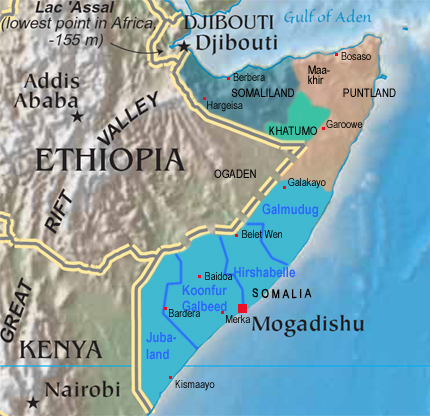
Map: Freeware, University of Texas Libraries, modyfied by: Volker Preuß

Area: 53.127 square miles
Inhabitants: 3.508.180 (2014), almost entirely Somali
Religions: 99% Muslim, Islam is state religion
Density of Population: 66 inh./sq.mi.
Capital: Hargeisa (Hargeysa), 861.000 inh. (2017)
official Languages: Somali, Arabian, English
Currency: Somaliland Shilling (SQS, SlSh)
Time Zone: GMT + 3 h
Source:
Wikipedia (D)

antiquity · trade between the Somali from Punt and Egypt, later also with the Roman Empire, the today’s Somaliland belongs to the Aksumit Empire
7th century · first contacts with the Islam at the coast, foundation of Zeila, Ifat and Hadja by Arabian traders from Yemen, evolution of islamic of town-states, islamization
13. Jahrhundert · Zeila becomes in Somaliland to the most important and most powerful state
1526 · conquest of Somaliland by the Empire of Adal
1548 · conquest of Somaliland by the Ottoman Empire
1630 · Somaliland comes under the reign of the Sherifs of Makkah (Hedjas), Ottoman supremacy
1830 · Ottoman supremacy under the rule of hereditary governors
7th of September 1877 · Somaliland comes under the rule of Egypt, Ottoman supremacy
February 1884 · United Kingdom takes over the rule in the former Egyptian Somaliland (1882 British conquest of Egypt)
20th of July 1887 · formation of the colony British-Somaliland, subordination under the administration of the British governor in Aden
1899–1920 · big anti-colonial revolt under Mullah Hadj Muhammad ibn Abdullah Hasan
1903 · British-Somaliland gets an own governor
19th of August 1940–16th of March 1941 · Second World War (1939-1945), occupation by Italian troops
26th of June 1960 · United Kingdom grants Somaliland independence under Premier Mohammed Haji Ibrahim Egal
1st of July 1960 · unification of the former Italian Somaliland with the former British Somaliland to the Republic of Somalia
1988 · the Somaliland Nationalist Movement (SNM) starts the armed struggle against the Somali central government under General Siyad Mohammed Barre
18th of May 1991 · Somaliland separates from Somalia
24th of May 1991 · proclamation of the Republic of Somaliland under President Abd-ar-Rahman Ahmad Ali Tur, the chief of the SNM
1993 · election of Mohammed Haji Ibrahim Egal to president
1997 · constitution
3rd of May 2002 · death of President Mohammed Haji Ibrahim Egal, successor is Dahir Riyale Kahin
2004 · death of Abd-ar-Rahman Ahmad Ali Tur
2007 · separation of the Maakhir State in the east of the country
2009 · Maakhir declares its annexation to Puntland
2012 · the State of Khatumo is formed in the east
2017 · the Khatumo State dissolves
2023 · the Khatumo State forms again, fighting breaks out with the Somaliland army
Source: Atlas zur Geschichte,
Wikipedia (DE),
World Statesmen

The name "Somaliland" has its roots in the name of the former colony British Somaliland and its inhabitants. They call themselves "Somali", which supposedly translates as "the hospitable". In Somali, the words "soo mal" mean something like "go and milk", possibly meant as an invitation to drink milk, which perhaps provides the explanation for the assumed hospitality. One can well imagine a foreign traveller landing by ship on the coast, meeting a local who points in the direction of his dwelling and calls out "soo mal", and the guest reinterpreting the gesture as naming the country. On the other hand, in the Cushitic languages of the Horn of Africa, which include Somali, the word "somal" means "dark" or "black", perhaps referring to the very dark skin colour of some Somalis. In Arabic, the word "zamla" means "cattle".
Source: Atlas der wahren Namen, Handbuch der geographischen Namen, Volker Preuß


![]()

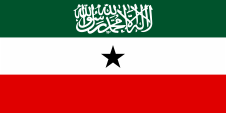



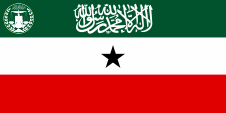




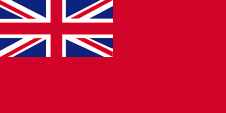



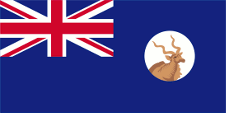
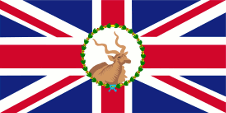
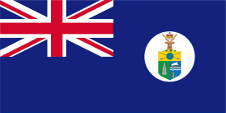
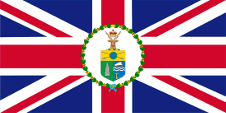
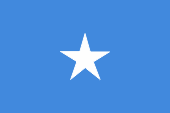


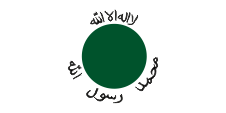





![]()
